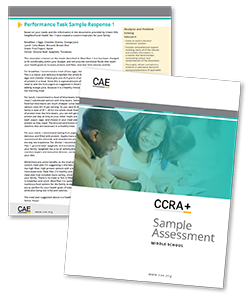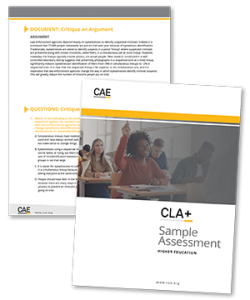 Formative Assessments: A Valuable Tool to Support Student Achievement
Formative Assessments: A Valuable Tool to Support Student Achievement
Formative assessments are a critical tool for teachers to monitor student progress, optimize their teaching methods, and enhance student learning.
Education leaders share strategies for measuring student learning throughout the year to inform instruction.

What is Formative Assessment?
The Council of Chief State School Officers defines formative assessment as “a planned, ongoing process used by all students and teachers during learning and teaching to elicit and use evidence of student learning to improve student understanding of intended disciplinary learning outcomes and support students to become self-directed learners.”
Performance assessments must be…

Planned and Ongoing
As the definition states, formative assessment is planned and ongoing. It involves using practices, methods, and tools that support all students in achieving challenging learning goals. This type of assessment is continuous, low-stakes, and responsive. Teachers and students collaborate to use the data from formative assessments to positively impact learning. They work together to identify and respond to strengths, interests, and needs.

A Collaborative Learning Process
Formative assessment is a collaborative learning process that happens “with” students, rather than “to” students. The process aims to make students active participants in their own learning, rather than passive recipients of information. Through this approach, teachers and students work together to develop a shared understanding of the students’ current learning status and what they need to do to move forward. This strategy encourages self-regulation and helps students adapt their learning strategies to meet their individual learning needs.

A Tool to Make Informed Decisions
Teachers and students can use formative assessment to know how well students understand the material they are learning and make decisions about additional instruction that may be needed during the practice phases of learning. Note that formative assessments are not intended to be used for calculating grades or for making placement decisions. Formative assessments are designed to provide insights into where students are at in their learning and to guide the teaching process as students continue their knowledge building.

Formative Assessment Examples
Examples of formative assessments include:
- Class discussions
- Self-assessments
- Performance-based assessments
- Peer assessments
- Quizzes
- And more
The goal of formative assessments is to help teachers and students to identify areas of strength and areas where continued learning is needed. Teachers also use the data to adjust their teaching methods and ultimately improve learning outcomes.
“Formative assessment data can offer more than just a retrospective measure of student academic performance, rather it can be a powerful tool to help educators improve student learning and skills in real time.” ~ Doris Zahner, Ph.D., CAE Chief Academic Officer
Formative Assessment Benefits
There are many ways formative assessments enhance student learning. Here are some of the chief benefits for educators and students:
Focused and Targeted Feedback
Formative assessments promote teacher-student communication, enabling individualized support for students.
Addresses Learning Gaps
Formative assessments help teachers identify and address student misconceptions and gaps in understanding.
Increased Student Engagement
Research shows that when formative assessments are used well, students become active participants in the learning process. This fosters learning, cultivates responsibility, and boosts intrinsic motivation.
Clear Learning Goals
Formative assessments measure student progress toward teacher-specified goals. Once students understand what they need to know or be able to do, formative assessments allow them to see how close they are to meeting those goals.
Self-Regulation
Studies show that formative assessments can boost self-regulation, which is crucial for lifelong learning. Self-regulated learning helps students identify their learning goals, manage their learning process, and evaluate their performance against goals.
Personalized Learning
Providing students with a personalized path for learning starts with an understanding of their strengths and areas for growth. Embedding formative assessments within lessons provides immediate feedback and enhances learning.
Rigorous Learning Environments
Teachers can use formative assessment data to determine student needs and create a more challenging learning environment that fosters student growth and success.
Five Formative Assessment Strategies
To get the most out of formative assessments, create a plan so you can implement them seamlessly and in a low-stakes way. Here are five tips to get started:
1. Define Clear Metrics and Goals
Start by defining clear performance criteria and discuss these with students to ensure understanding.
2. Assess Early and Often
Formative assessment requires frequent monitoring of student performance through current data. It is best to assess early and often to ensure optimal results.
3. Encourage Peer Discussions
Teachers should encourage group discussions among students to gain insights into their concerns and define learning goals.
4. Encourage Student Self-Evaluation
Asking students to evaluate their progress will help identify areas for improvement and can increase engagement in their learning. It will also save time and make the formative assessment more manageable.
5. Provide Comprehensive Feedback
Feedback should be constructive and focused on helping students correct mistakes. This means providing specific advice and guidance on how to overcome the problem.
Build Higher-Order Skills with CAE’s Formative Assessments
Preparing all students for success is a complex task that requires a multifaceted approach. While content knowledge is essential, equally important are higher-order skills.
Higher-order skills are a set of personal attributes and abilities that allow individuals to thrive academically, professionally, and personally. These skills include being able to think critically, communicate effectively, collaborate with others, and solve problems. A large body of research confirms the need to teach students higher-order skills alongside traditional academic content to prepare them for future success. In response, school districts, higher education institutions, and even the Department of Education are shifting instructional and assessment approaches to be more competency based.
CAE’s Formative Assessments for K–12 and Higher Education
 CAE offers two performance-based assessments: College and Career Readiness Assessment (CCRA+) for secondary education and Collegiate Learning Assessment (CLA+) for higher education. Both versions authentically measure students’ higher-order skills, including critical thinking, problem solving, and effective written communication.
CAE offers two performance-based assessments: College and Career Readiness Assessment (CCRA+) for secondary education and Collegiate Learning Assessment (CLA+) for higher education. Both versions authentically measure students’ higher-order skills, including critical thinking, problem solving, and effective written communication.
CCRA+ and CLA+ can be used as a formative assessment tool, and students may take them several times throughout the school year to give teachers more information about what students know and can do. The assessment results—along with other schoolwork and classroom observations—help teachers identify where students are flourishing and where they need more help.
CAE also offers actionable data reports that can be utilized for both formative and summative purposes. These reports are helpful in evaluating a student’s progress in developing higher-order skills at the start and/or end of a specific class or academic year. Additionally, they can be used to measure growth over multiple years.
Preview CAE’s Formative Assessments
CAE’s CCRA+ and CLA+ assessments evaluate students’ proficiency in higher-order skills. These performance-based assessments present real-world scenarios that require students to apply critical thinking, problem-solving, and written communication skills to recommend solutions. Take a look at these samples to get a better understanding of how these assessments work.
CAE’s Custom Formative Assessments
In addition to CCRA+ and CLA+, CAE provides a wide range of custom assessment services. From initial design and development to test delivery, scoring, and analyses, we provide innovative assessments that measure the constructs most important to students, educators, and institutions.
These assessments cover all subject areas, as well as non-content areas such as higher-order skills like critical thinking, problem solving, and written communication. Additionally, they provide insights into social-emotional competence, collaboration, creativity, and more.
CAE’s custom assessments focus on knowledge application and are available for formative, interim, and summative purposes, using various testing methods.
Learn more about CAE’s custom formative assessments and our Higher-Order Skills Solution. Schedule a time to chat with us!


